


|
| ||
|
|
|
|
|
|
SILVER EDITION

|


|
SILVER EDITION |
|
Publication History
Cover Overview |
Reviews and Previews
Chapter Overview |
Word Cloud
[NEW]
First Chapter Preview [NEW] |
Cover Gallery (year)
Cover Gallery (edition) |
 Cover Overview
Cover Overview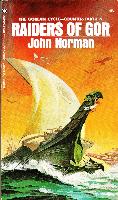
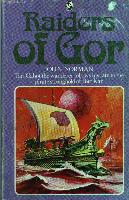
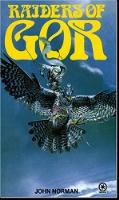
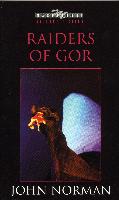

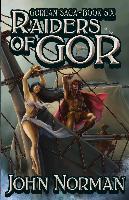


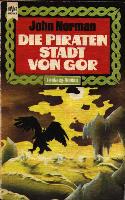
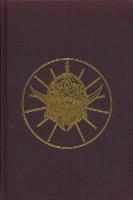

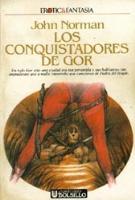
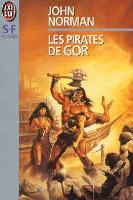
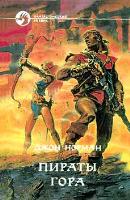
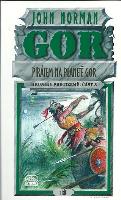
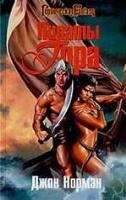
 Reviews and Previews
Reviews and PreviewsHere is an overview of the 18 chapters in Raiders of Gor:
|
1. The Blood Mark
2. The Cries of Marsh Gants 3. Ho-Hak 4. The Hut 5. Festival 6. Slavers 7. I Will Hunt 8. What Occurred in the Marshes 9. Port Kar |
10. The Council of Captains
11. The Crest of Sleen Hair 12. I Fish in the Canal 13. How Bosk Came to be Pirate 14. How Bosk Conducted Business Upon Thassa 15. How Bosk Returned in Triumph to Port Kar 16. What Occurred One Night in Port Kar 17. How Bosk Conducted the Affairs of Port Kar Upon Thassa 18. How Bosk Returned to His Home |
 Word Cloud
Word CloudThe image below shows the most often used words and terms within Raiders of Gor. The larger the size, the more often the word or term occurs in the text.
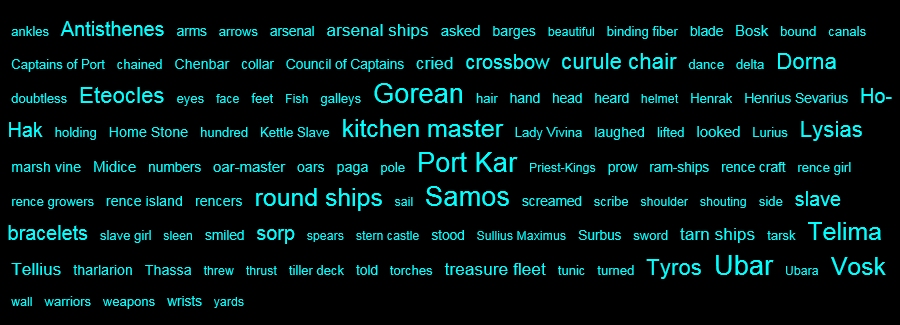
 First Chapter Preview
First Chapter Preview
1
The Blood Mark
I could smell the sea, gleaming Thassa, in the myths said to be without a farther shore.
I reached down from the rush craft and took a palm of water into my hand and touched my tongue to it. Thassa could not be far beyond.
I took the triangular-bladed tem-wood paddle and moved the small craft, light and narrow, large enough scarcely for one man, ahead. It was formed of pliant, tubular, lengthy Vosk rushes, bound with marsh vine.
To my right, some two or three feet under the water, I saw the sudden, rolling yellowish flash of the slatted belly of a water tharlarion, turning as it made its swift strike, probably a Vosk carp or marsh turtle. Immediately following I saw the water seem to glitter for a moment, a rain of yellowish streaks beneath the surface, in the wake of the water tharlarion, doubtless its swarm of scavengers, tiny water tharlarion, about six inches long, little more than teeth and tail.
A brightly plumaged bird sprang from the rushes to my left, screaming and beating its sudden way into the blue sky. In a moment it had darted again downward to be lost in the rushes, the waving spore stalks, the seed pods of various growths of the Gorean tidal marshes. Only one creature in the marshes dares to outline itself against the sky, the predatory Ul, the winged tharlarion.
It was difficult to see more than a few feet ahead; sometimes I could see no further than the lifted prow of my small craft, as it nosed its way among the rushes and the frequent rence plants.
It was the fourth day of the sixth passage hand, shortly before the Autumnal Equinox, which in the common Gorean calendar begins the month of Se'Kara. In the calendar of Ko-ro-ba, which, like most Gorean cities, marks years by its Administrator Lists, it would be the eleventh year of the administration of my father, Matthew Cabot. In the calendar of Ar, for those it might interest, it was the first year of the restoration of Marlenus, Ubar of Ubars, but, more usefully for the purposes of consolidating the normal chaos of Gorean chronology, it was the year 10,119 Contasta Ar, that is, from the founding of Ar.
My weapons shared the boat, with a gourd of water and a tin of bread and dried bosk meat. I had the Gorean short sword in its scabbard, my shield and helmet, and, wrapped in leather, a Gorean long bow of supple Ka-la-na wood, from the yellow wine trees of Gor, tipped with notched bosk horn at each end, loose strung with hemp whipped with silk, and a roll of sheaf and flight arrows. The bow is not commonly favored by Gorean warriors, but all must respect it. It is the height of a tall man; its back, away from the bowman, is flat; its belly, facing the bowman, is half-rounded; it is something like an inch and a half wide and an inch and a quarter thick at the center; it has considerable force and requires considerable strength to draw; many men, incidentally, even some warriors, cannot draw the bow; nine of its arrows can be fired aloft before the first falls again to the earth; at point-blank range it can be fired completely through a four-inch beam; at two hundred yards it can pin a man to a wall; at four hundred yards it can kill the huge, shambling bosk; its rate of fire is nineteen arrows in a Gorean Ehn, about eighty Earth seconds; and a skilled bowman, but not an extraordinary one, is expected to be able to place these nineteen arrows in one Ehn into a target, the size of a man, each a hit, at a range of some two hundred and fifty yards. Yet, as a weapon, it has serious disadvantages, and on Gor the crossbow, inferior in accuracy, range and rate of fire, with its heavy cable and its leaves of steel, tends to be generally favored. The long bow cannot well be used except in a standing, or at least kneeling, position, thus making more of a target of the archer; the long bow is difficult to use from the saddle; it is impractical in close quarters, as in defensive warfare or in fighting from room to room; and it cannot be kept set, loaded like a firearm, as can the crossbow; the crossbow is the assassin's weapon, par excellence; further, it might be mentioned that, although it takes longer to set the crossbow, a weaker man, with, say, his belt claw or his winding gear, can certainly manage to do so; accordingly, for every man capable of drawing a warrior's long bow there will be an indefinite number who can use the crossbow; lastly, at shorter distances, the crossbow requires much less skill for accuracy than the long bow.
I smiled to myself.
It is not difficult to see why, popularly, the crossbow should be regarded as a generally more efficient weapon than the long bow, in spite of being inferior to it, in the hands of an expert, in range, accuracy and rate of fire. Well used, the long bow is a far more devastating weapon than its rival, the crossbow; but few men had the strength and eye to use it well; I prided myself on my skill with the weapon.
I paddled along, gently, kneeling on the rushes of my small, narrow craft.
It is the weapon of a peasant, I heard echoing in my mind, and again smiled. The Older Tarl, my former master-at-arms, had so spoken to me years before in Ko-ro-ba, my city, the Towers of the Morning. I looked down at the long, heavy, leather-wrapped bow of supple Ka-la-na wood in the bottom of the rush craft.
I laughed.
It was true that the long bow is a weapon of peasants, who make and use them, sometimes with great efficiency. That fact, in itself, that the long bow is a peasant weapon, would make many Goreans, particularly those not familiar with the bow, look down upon it. Gorean warriors, generally drawn from the cities, are warriors by blood, by caste; moreover, they are High Caste; the peasants, isolated in their narrow fields and villages, are Low Caste; indeed, the Peasant is regarded, by those of the cities, as being little more than an ignoble brute, ignorant and superstitious, venal and vicious, a grubber in the dirt, a plodding animal, an ill-tempered beast, something at best cunning and treacherous; and yet I knew that in each dirt-floored cone of straw that served as the dwelling place of a peasant and his family, there was, by the fire hole, a Home Stone; the peasants themselves, though regarded as the lowest caste on all Gor by most Goreans, call themselves proudly the ox on which the Home Stone rests, and I think their saying is true.
Peasants, incidentally, are seldom, except in emergencies, utilized in the armed forces of a city; this is a further reason why their weapon, the long bow, is less known in the cities, and among warriors, than it deserves to be.
The Gorean, to my mind, is often, though not always, bound by historical accidents and cultural traditions, which are then often rationalized into a semblance of plausibility. For example, I had even heard arguments to the effect that peasants used the long bow only because they lacked the manufacturing capability to produce crossbows, as though they could not have traded their goods or sold animals to obtain crossbows, if they wished. Further, the heavy, bronze-headed spear and the short, double-edged steel sword are traditionally regarded as the worthy, and prime, weapons of the Gorean fighting man, he at least who is a true fighting man; and, similarly traditionally, archers, who slay from a distance, not coming to grips with their enemy, with their almost invisible, swiftly moving shafts of wood, those mere splinters, are regarded as being rather contemptible, almost on the periphery of warriorhood; villains in Gorean epics, incidentally, when not of small and despised castes, are likely to be archers; I had heard warriors say that they would rather be poisoned by a woman than slain by an arrow.
I myself, perhaps because I had been raised not on Gor, but on Earth, did not, fortunately in my opinion, suffer from these inhibiting prepossessions; I could use the long bow with, so to speak, no tincture of shame, no confusion of conscience, without the least injury to my self-esteem; I knew the long bow to be a magnificent weapon; accordingly, I made it my own.
I heard a bird some forty or fifty yards to my right; it sounded like a marsh gant, a small, horned, web-footed aquatic fowl, broad-billed and broad-winged. Marsh girls, the daughters of rence growers, sometimes hunt them with throwing sticks.
In some cities, Port Kar, for example, the long bow is almost unknown. Similarly it is not widely known even in Glorious Ar, the largest city of known Gor. It is reasonably well known in Thentis, in the Mountains of Thentis, famed for her tarn flocks, and in Ko-ro-ba, my city, the Towers of the Morning. Cities vary. But generally the bow is little known. Small straight bows, of course, not the powerful long bow, are, on the other hand, reasonably common on Gor, and these are often used for hunting light game, such as the brush-maned, three-toed Qualae, the yellow-pelted, single-horned tabuk, and runaway slaves.
I heard another bird, another marsh gant it seemed, some fifty yards away, but this time to my left.
It was late in the afternoon, the fourteenth Gorean Ahn I would have guessed. Some swarms of insects hung in the sedge here and there but I had not been much bothered; it was late in the year, and most of the Gorean insects likely to make life miserable for men bred in, and frequented, areas in which bodies of unmoving, fresh water were plentiful. I did see a large, harmless zarlit fly, purple, about two feet long with four translucent wings, spanning about a yard, humming over the surface of the water, then alighting and, on its padlike feet, daintily picking its way across the surface. I flicked a salt leech from the side of my light rush craft with the corner of the tem-wood paddle.
On river barges, for hundreds of pasangs, I had made my way down the Vosk, but where the mighty Vosk began to break apart and spread into its hundreds of shallow, constantly shifting channels, becoming lost in the vast tidal marshes of its delta, moving toward gleaming Thassa, the Sea, I had abandoned the barges, purchasing from rence growers on the eastern periphery of the delta supplies and the small rush craft which I now propelled through the rushes and sedge, the wild rence plants.
I noticed that one of these rence plants had, tied about it, below the tuft of stamens and narrow petals, a white cloth, rep-cloth.
I paddled over to look at the cloth. I looked about myself, and was for some time quiet, not moving. Then I moved past the plant, parting the rence and passing through.
I heard again the cry of the marsh gant, from somewhere behind me.
No one had been found who would guide me into the delta of the Vosk. The bargemen of the Vosk will not take their wide, broad-bottomed craft into the delta. The channels of the Vosk, to be sure, shift from season to season, and the delta is often little more than a trackless marsh, literally hundreds of square pasangs of estuarial wilderness. In many places it is too shallow to float even the great flat-bottomed barges and, more importantly, a path for them would have to be cut and chopped, foot by foot, through the thickets of rush and sedge, and the tangles of marsh vine. The most important reason for not finding a guide, of course, even among the eastern rence growers, is that the delta is claimed by Port Kar, which lies within it, some hundred pasangs from its northwestern edge, bordering on the shallow Tamber Gulf, beyond which is gleaming Thassa, the Sea.
Port Kar, crowded, squalid, malignant, is sometimes referred to as the Tarn of the Sea. Her name is a synonym in Gorean for cruelty and piracy. The fleets of tarn ships of Port Kar are the scourge of Thassa, beautiful, lateen-rigged galleys that ply the trade of plunder and enslavement from the Ta-Thassa Mountains of the southern hemisphere of Gor to the ice lakes of the North; and westward even beyond the terraced island of Cos and the rocky Tyros, with its labyrinths of vart caves.
I knew one in Port Kar, by name Samos, a slaver, said to be an agent of Priest-Kings.
I was in the delta of the Vosk, and making my way to the city of Port Kar, which alone of Gorean cities commonly welcomes strangers, though few but exiles, murderers, outlaws, thieves and cutthroats would care to find their way to her canaled darknesses.
I recalled Samos, slumped in his marble chair at the Curulean in Ar, seemingly indolent, but indolent as might be the satisfied beast of prey. About his left shoulder, in the manner of his city, he had worn the knotted ropes of Port Kar; his garment had been simple, dark and closely woven; the hood had been thrown back, revealing his broad, wide head, the close-cropped white hair; the face had been red from windburn and salt; it had been wrinkled and lined, cracked like leather; in his ears there had been two small golden rings; in him I had sensed power, experience, intelligence, cruelty; I had felt in him the presence of the carnivore, at that moment not inclined to hunt or kill. I did not look forward to meeting him. Yet it was said, by those I trusted, that he had served Priest-Kings well.
I was not particularly surprised at finding a bit of rep-cloth tied on the rence plant, for the delta is inhabited. Man has not surrendered it entirely to the tharlarion, the Ul and the salt leech. There are scattered, almost invisible, furtive communities of rence growers who eke out their livelihood in the delta, nominally under the suzerainty of Port Kar. The cloth I found had probably been a trail mark for some rence growers.
A kind of paper is made from rence. The plant itself has a long, thick root, about four inches thick, which lies horizontally under the surface of the water; small roots sink downward into the mud from this main root, and several "stems," as many as a dozen, rise from it, often of a length of fifteen to sixteen feet from the root; it has an excrescent, usually single floral spike.
The plant has many uses besides serving as a raw product in the manufacture of rence paper. The root, which is woody and heavy, is used for certain wooden tools and utensils, which can be carved from it; also, when dried, it makes a good fuel; from the stem the rence growers can make reed boats, sails, mats, cords and a kind of fibrous cloth; further, its pith is edible, and for the rence growers is, with fish, a staple in their diet; the pith is edible both raw and cooked; some men, lost in the delta, not knowing the pith edible, have died of starvation in the midst of what was, had they known it, an almost endless abundance of food. The pith is also used, upon occasion, as a caulking for boat seams, but tow and pitch, covered with tar or grease, are generally used.
Rence paper is made by slicing the stem into thin, narrow strips; those near the center of the plant are particularly favored; one layer of strips is placed longitudinally, and then a shorter layer is placed latitudinally across the first layer; these two surfaces are then soaked under water, which releases a gluelike substance from the fibers, melding the two surfaces into a single, rectangular sheet; these formed sheets are then hammered and dried in the sun; roughness is removed by polishing, usually with a smooth shell or a bit of kailiauk horn; the side of a tharlarion tooth may also be used in this work. The paper is then attached, sheet to sheet, to form rolls, usually about twenty sheets to a roll. The best paper is on the outside of the roll, always, not to practice deceit in the quality of the roll but rather to have the most durable paper on the outside, which will take the most weathering, handling and general wear. Rence paper comes in various grades, about eight in all. The rence growers market their product either at the eastern or western end of the delta. Sometimes rence merchants, on narrow marsh craft rowed by slaves, enter some pasangs into the delta to negotiate the transactions, usually from the western edge, that bordering the Tamber Gulf. Rence paper is, incidentally, not the only type of writing material used on Gor. A milled linen paper is much used, large quantities of which are produced in Ar, and vellum and grosser parchment, prepared in many cities, are also popular.
I now noted another bit of white rep-cloth tied on a rence stem, larger than the first. I assumed it was another trail mark. I continued on. The calls of marsh gants, a kind of piping whistle, seemed more frequent now, and somewhat closer. I looked behind me, and to the sides. Yet, not surprisingly, because of the rence, the rushes and sedge, I could not see the birds.
I had been in the delta now for some sixteen days, drifting and paddling toward Thassa. I again tasted the water, and the salt of it was even stronger than it had been. And the great, vast clean smell of Thassa was clear.
I rejoiced, moving ahead. There was not much water left in the gourd now, and it was the last of several I had brought with me. The dried bosk meat in the tin, and the bread with it, yellow Sa-Tarna bread, now stale, was almost gone.
Then I stopped short, for tied to a rence plant before me now was a sheaf of red cloth.
I then knew that the two pieces of cloth I had encountered earlier had not been simple trail marks but boundary signs, warnings. I had come into an area of the delta where I was not welcome, into a territory that must be claimed by some small community, doubtless, of rence growers.
The rence growers, in spite of the value of their product, and the value of articles taken in exchange for it, and the protection of the marshes, and the rence and fish which give them ample sustenance, do not have an easy life. Not only must they fear the marsh sharks and the carnivorous eels which frequent the lower delta, not to mention the various species of aggressive water tharlarion and the winged, monstrous, hissing, predatory Ul, but they must fear, perhaps most of all, men, and of these, most of all, the men of Port Kar.
As I have mentioned, Port Kar claims the suzerainty of the delta. Accordingly, frequently, bands of armed men, maintaining allegiance to one or the other of the warring, rival Ubars of Port Kar, enter the delta to, as they say, collect taxes. The tributes exacted, when the small communities can be found, are customarily harsh, often whatever of value can be found; typically what is demanded is great stocks of rence paper for trade, sons for oarsmen in cargo galleys, daughters for Pleasure Slaves in the taverns of the city.
I looked on the red cloth tied to the rence plant. The cloth was the color of blood; I was in little doubt as to its meaning. I was not to proceed farther.
I moved the small, light craft through the rushes, past the sign. I must make my way to Port Kar.
The cries of marsh gants followed me.
 Cover Gallery (year)
Cover Gallery (year)Here is a cover gallery showing all the editions and printings of Raiders of Gor, sorted by year of publication. Click on any cover to see the book.


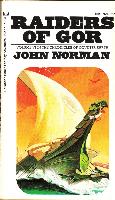
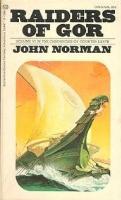


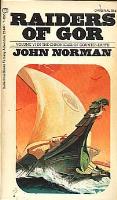
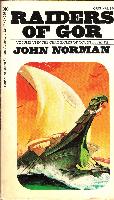
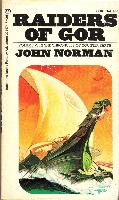
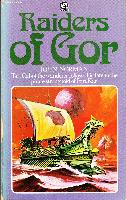

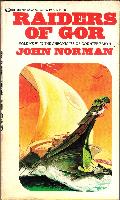
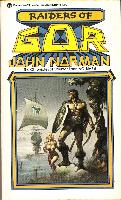

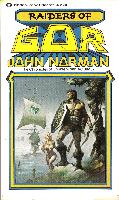
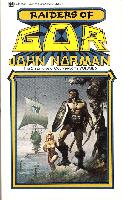
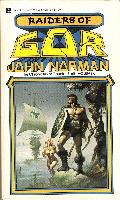
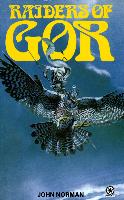


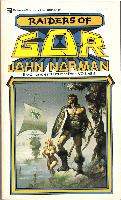
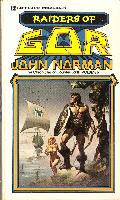

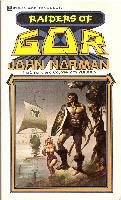
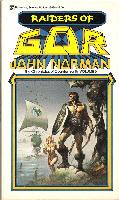


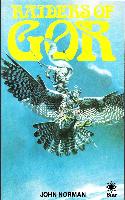
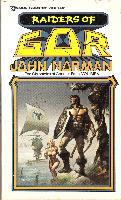

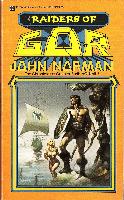









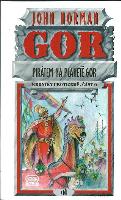

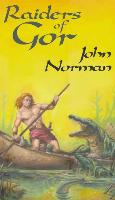







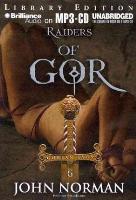
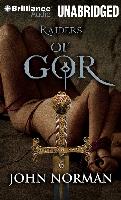
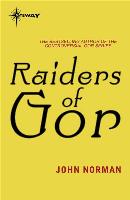
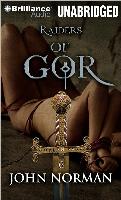
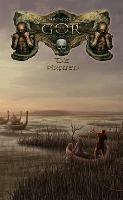

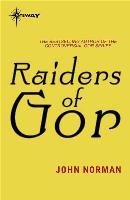
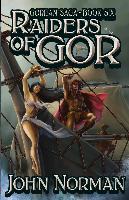
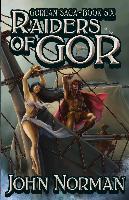

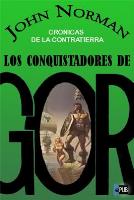

 Cover Gallery (edition)
Cover Gallery (edition)Here is a cover gallery showing all the editions and printings of Raiders of Gor, sorted by edition. Click on any cover to see the book.






























































 This page is copyright © 2000/2013 by Simon van Meygaarden & Jon Ard - All Rights Reserved
This page is copyright © 2000/2013 by Simon van Meygaarden & Jon Ard - All Rights Reserved